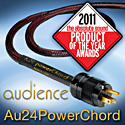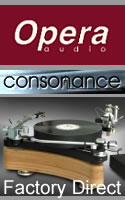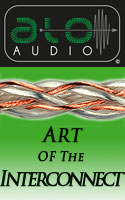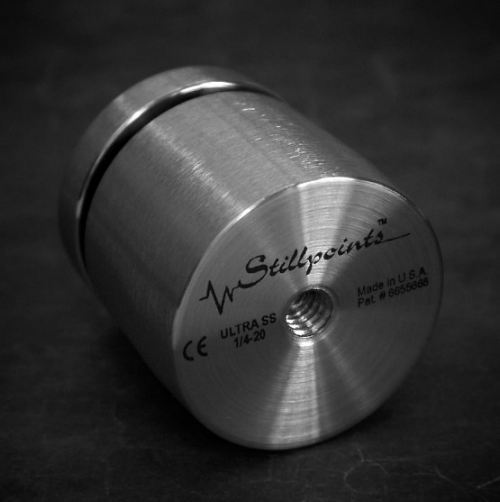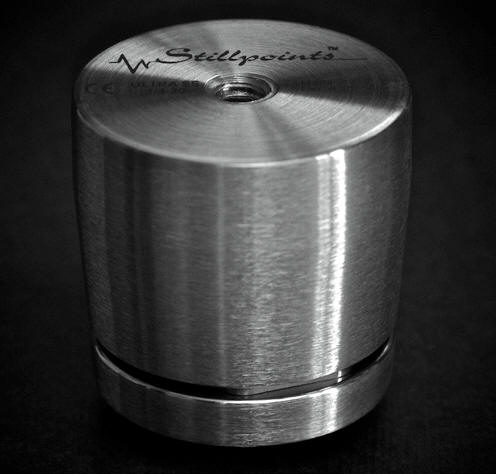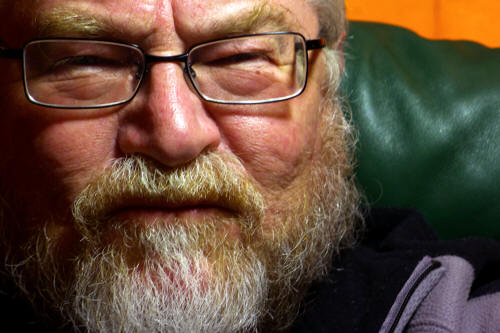|
|
You are reading the older HTML site
Positive Feedback ISSUE 60
stillpoints One Reason Audio and Recording Equipment Falls Short: Stillpoints Ultras to the Rescue as reviewed by Jim Merod
Wanna Bet? Elmer, my crazy neighbor down the street, is certain that his audio set up is always just about to sing like Whitney Houston. He's perpetually on the verge of a major breakthrough in sonic and musical resolution. I'll get his call, usually around dinner time, to scurry down to hear his latest and greatest achievement. If the audiophile world is defined with hope chased by money ill-invested, then Elmer is preparing to write the book, complete with roadmaps that describe how to go wrong by taking the fork in the road right over the cliff. So, recently, in a reasonable frame of mind just short of good humor, I sauntered down to Elmer's fancy shack. His vista can make a grown man weep with its Technicolor sunsets. I doubt he notices them much anymore since his heart and mind are lost in tweaking new gear. Not that Elmer truly cares about state-of-the-art audio glory, for that matter. He enjoys the exercise of swapping gear in and out, a never ceasing quest for... well, I'm not certain. This trek down to his salubrious pad, without exception, confronts behemoth speakers sold on-line straight from Australia. Or boffo huge tubed preamps out of Hong Kong. Sometimes one comes upon cables the size of pythons stuffed with full grown pigs. The multi-driver monsters I recently encountered there were nearly the height of Elmer's considerably tall listening room. They stood well away from back and side walls. He had new 250-watt class A mono block amplifiers in dual stereo configuration, each speaker array bi-amped... leading me to tease him that a dual tri-amped system would be far better in theory. Maybe even in practice ...leading Elmer to scowl at me and bark a gruff invitation to pull two quart bottles of Belgian ale from the fridge so we could seriously dig his sonic show. I've known this bloke quite a while and I've made an increasingly desultory pilgrimage to his spectacular hacienda many times. If I had better recollection of his circulating gear and its price tags, I could make a better estimate of his investment in perpetual optimism, a sum total divestment in his not inconsiderable net worth. Suffice it to imagine that over the last decade, something on the order of $800,000 plus has gone in and out of Elmer's, just about nearly almost (soon to be) boffo state-of-the-art audiophile system. If a piece of music reproduction equipment is expensive, he buys it. Whatever the pieces of very expensive gear brought together might be, it inevitably fails since—like the moonstruck racetrack hound who dogs Del Mar Race Track each day of its annual summer meeting near the blue Pacific—Elmer seems cursed by attraction to mismatched logic, or illogic, of his approach to putting equipment, losing tickets, lost umbrellas, nags that can't win, and jockeys thrown from the saddle coming out of the gate. It's not that he's dumb exactly, or cursed with the usual pathos of eternal hope blinded by infinite bad luck. It's simply that Elmer has no touch. Everyone knows that in 1941 Joe DiMaggio hit safely in 56 straight games. And Ruth called his home run shot with Ruthian bravado in the '31 World Series. Less known is the fact that St. Louis Cardinal hall of fame second baseman, Red Schoendienst, who nearly beat the Dodgers' Carl Furillo for the 1954 batting championship, told teammates on the National League bench during the 1950 All Star Game in Chicago's Comisky Park, that he was going to end the tied game with a poke into the left field stands in the 14th inning. He did it. Schoendienst turned 90 years old this month and I'm sure he thinks about that lucky, but successful, inspiration still today, sixty years later. Like Michael Jordan on a hot shooting streak (or Marilyn Monroe stalking big time politicians, athletes, and writers) each of these examples of world class public success is a matter of perfect touch. "Lucky" gamblers have an uncanny touch with dice or cards or ponies. Ruth and DiMaggio had consistently uncanny touch at the plate, like Jordan at the end of a playoff game who always took the last shot. Everyone knew it was coming. No one could do anything about it. He had "touch" like Shakespeare had dramatic verbal magic anytime he needed it. Not Elmer. The guy can't put a decent sound rig together regardless of cost. He's a living, breathing, semi-ambulatory embodiment of the old adage: Nel mezzo del camin . Well, okay, not that one. But no doubt this: Quanto si sta fermo qui? And this too:each lunkhead knipperdollin' ignores his own idiocy! And this no less :Once a dork, always a dork. Don't Bet On It Poor Elmer has no touch and no clue simply because he thinks money is the key to audio glory. He's attracted to audiophile halitosis, a condition akin to sonic narcolepsy. If a sixty thousand dollar amplifier is great, then an eighty-five thousand dollar amp is obviously greater. And so on across the board. Gear is as good as the price tag it carries. Elmer, despite more than a decade of failure, is sure of that inveterate wisdom. But, then, what is "audio touch?" What element in the crafting of superior home reproduction sound is this poor fellow overlooking? Just as a remarkably vivid, nearly holographic recording can be captured using quite distinctly ordinary microphones, and recording equipment, as long as the recordist understands the acoustical context of the music to be snagged and how to keep the sonic pick up in phase. So a vivacious and musically-beguiling sound rig can be cobbled together with fairly inexpensive gear ...if a few magical rules of the audio road are religiously observed. I know of no "audio handbook" that pontificates on permutations of gear that can be brought together and matched for less than blockbuster costs, but with more than merely "better than average" musical results. If such a manual exists, I'd be interested to read it. In its possible commercial absence, I'll note an opportunity for some knowledgeable and enterprising audiophile. Such a text could be valuable for those seeking superior music reproductions at less than inflated dollar outlays. The secret of great sound is well matched components along with canny set up and room placement. But there is one more virtually insurmountable magical trick to be employed in any sound system, at any price, that I'm aware of. It seems almost self-evident, on one hand, and yet it often seems to disappear into obscurity, slipping through many other hands seeking audio good luck or exquisite touch. Stillpoints Ultras, Audio Magic Devices
These not inconsiderably bulky sonic enhancement feet are hiding in plain sight for any less than happy audiophile who feels less than connected to their music. I'll keep this simple. Place four of the "Ultras" underneath a speaker. Bang! More 'there' is fully 'there'... more detail, dynamic heft and clarity; more resolution with relaxed transparency. Do the same for your companion speaker. Wham! Now you've enhanced the final stage of your sound rig to a maximum degree while doing nothing more exotic than putting these extremely well crafted metal vibration isolation devices under the final element of sonic delivery. Maestro Wakeen advised me that Stillpoints products have a patented vibration isolation filter which contains multiple levels of stacked bearings that convert vibration into unwanted energy dissipated. Ultras, he believes, are the only device that truly isolates equipment. In the Stillpoints design, there is no direct vertical continuous contact. All other devices, to his knowledge, he noted, are structured to be directly vertical continuous contact and thus are damping units. Place a set of Ultras under an amplifier. Same result as you'll find from their effect on speakers: more musical glory. Preamplifier: increased detail, more stable images. Try them beneath your disc transport, which may eventuate in a jaw-dropping experience for you... as if you'd just inherited a new playback front end; as if nuances and macro-elements of staging, dynamic layering, and ambient texture appeared out of nowhere. This is serious stuff, and guys like Elmer (who I mentioned Stillpoints Ultras to, not long ago), passing up such a failsafe instance of mega-improvement, verify their lack of audio common sense. If something ain't broke, don't fix it. And yet so many earnest music lovers find themselves surrounded by inferior playback realties. When a sound system is not enchanting you, it has become as "slick as a broke dick dog," to quote that cryptic philosophical guru Miles Davis. A less than satisfying audio rig is like a Porsche up on blocks, or Selma Hayek, newly arrived next door, perpetually on vacation. Second best is, by definition, relative. But when you experience your musical cosmos to be less than first rate—however you evaluate that—then it's time to cut the BS and find a way to make more out of your disappointing less. I cannot name anything that boosts audio reproductive glory with greater certainty and sure-footed repetitive joy than Paul Wakeen's Stillpoint Ultras. These are not some recent experiment with vibration diminishment, dampening, and elimination. Maestro Wakeen has been after this elusive sonic quarry for more than a decade. I remember a conversation over dinner I had with him on the order of fifteen years ago, when we mulled over the transferrable utility of earthquake vibration containment to the infinitely more refined and micro logical world of music reproduction. The impressive devices Paul had created at that point were quite good indeed. They made an absolutely positive difference in enhancing sound in a good system. But, over time, his indefatigable quest for vibration elimination has continued unabated toward degrees of ever diminishing perfection. I cannot here today predict that the Ultras, as amazing as they truly are, will be the final iteration of this creative man's search for greater sonic accuracy. But I will conclude, for the purpose of this review (until later notice when more might need to be added to the record of his achievement), with one unimpeachable fact about these splendid units. Live Sound Well-Recorded "On Location" In Pursuit Of Truthful Musical Reality Those who know my mania across more than three decades to capture live music—big bands at Birdland; great vocalists like Tierney Sutton, Judy Collins, Jackie Ryan, Sarah Vaughan, and Lucianna Souza; intimate jazz trios or quintets at Catalina in Los Angeles —a Quixote-like pilgrimage toward an always receding horizon. Anyone who wishes to snare real music with the full textural vibrancy and dynamic complexity of ambient truth, must have a bolt missing. Thus, I confess to at least one lost bolt, but I also insist upon constantly revived attempts to come closer to the full of musical truth. In the last set of months, with Stillpoint Ultras in place under my main recording unit, I've found that the prospect of very good recordings eventuated in excellent recordings I've made recently with Arturo O'Farril's Afro-Latin Sextet, with Kenny Werner's All Star Quintet, with Randy Brecker and David Sanchez, and with Christian Jacobs' Big Band. The recorded clarity and mastered details of both audio capture and transfer are an order of sonic magnitude higher than I've previously counted on. I simply cannot say anything more laudatory to valorize my faith and astonished admiration for any piece of "audio and recording gear." I regard these innocently deceptive units as part of an improved recording system. Stillpoints Ultras are better than good. They have perfected the mysterious art of adding to musical pleasure and sonic enchantment by subtracting unwanted, deleterious nonmusical intrusions. They literally define an unbroken promise of sonic pleasure for any and every music reproduction system that includes their enigmatic beauty to enhance an audiophile's (or recording engineer's) fragile hope for sound at its ultimate realization with solidity of staging, rhythmic pace, and that inexplicably evanescent final accomplishment, seductive delicacy suffused with hypnotic energy. Jim Merod
Ultras
Stillpoints
|
